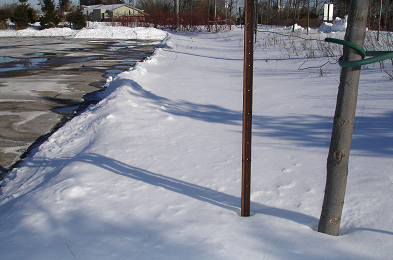Difference between revisions of "Winter Management"
Jenny Hill (talk | contribs) |
Jenny Hill (talk | contribs) |
||
| Line 2: | Line 2: | ||
<div class="col-md-8"> | <div class="col-md-8"> | ||
{{TOClimit|2}} | {{TOClimit|2}} | ||
| − | <p>Sodium and chloride ions in de-icing salts applied to asphalt areas travel easily with the runoff water. De-icing salt can also increase the mobility of some heavy metals in soil (e.g. | + | <p>Sodium and chloride ions in de-icing salts applied to asphalt areas travel easily with the runoff water. De-icing salt can also increase the mobility of some heavy metals in soil (e.g. lead, copper or cadmium). This may increase the downstream concentration of the metal(Amrhein et al., 1992; Bauske and Goetz, 1993). </p> |
<p> <strong>Very few studies have sampled groundwater below infiltration facilities or roadside ditches receiving de-icing salt laden runoff have found concentrations of heavy metals that exceed drinking water standards (e.g., Howard and Beck, 1993; Granato et al., 1995).</strong> </p> | <p> <strong>Very few studies have sampled groundwater below infiltration facilities or roadside ditches receiving de-icing salt laden runoff have found concentrations of heavy metals that exceed drinking water standards (e.g., Howard and Beck, 1993; Granato et al., 1995).</strong> </p> | ||
<p>To minimize risk of groundwater or soil contamination, the following management approaches are recommended (Pitt et al., 1999; TRCA, 2009b): | <p>To minimize risk of groundwater or soil contamination, the following management approaches are recommended (Pitt et al., 1999; TRCA, 2009b): | ||
Revision as of 19:56, 5 June 2017
Salt and Snow[edit]
Sodium and chloride ions in de-icing salts applied to asphalt areas travel easily with the runoff water. De-icing salt can also increase the mobility of some heavy metals in soil (e.g. lead, copper or cadmium). This may increase the downstream concentration of the metal(Amrhein et al., 1992; Bauske and Goetz, 1993).
Very few studies have sampled groundwater below infiltration facilities or roadside ditches receiving de-icing salt laden runoff have found concentrations of heavy metals that exceed drinking water standards (e.g., Howard and Beck, 1993; Granato et al., 1995).
To minimize risk of groundwater or soil contamination, the following management approaches are recommended (Pitt et al., 1999; TRCA, 2009b):
- Stormwater infiltration practices should not receive runoff from the following areas:
- Where large amounts of de-icing salts are applied (e.g., busy highways), or
- Pollution hot spots (e.g. vehicle fuelling, servicing or demolition areas, outdoor storage or handling areas for hazardous materials, and some heavy industry sites);
- Prioritize infiltration of runoff from source areas that are comparatively less contaminated such as roofs, low traffic roads and parking areas; and
- Apply pre-treatment practices before infiltration of road or parking area runoff.
Vegetation varies in its reaction to salt-affected soils.
- Salt in soil water generally makes it more difficult for roots to take up water. This phenomenon mimics drought conditions for the plant.
- If passing traffic sprays salty water onto plants it can reduce cold hardiness in buds and new twigs. These then become more susceptible to freezing, mortality or deformation.
- In high enough concentrations sodium and chloride can also be directly toxic to plants. In some species the ions are absorbed by t he plant and build up in the leaves causing them to die
Generally, the vegetation growing closest to the source will be most strongly affected by salt.
Plants actively growing in late winter (when salt levels are highest) are also more significantly affected. So, warm season grasses offer an advantage over cool season grasses, because they emerge later in the spring when excess salt has been flushed away.
Freezing and Expansion[edit]
Freezing temperatures can cause problems with pipes and cisterns exposed above the frost penetration line[1]. This maybe a significant issue for rainwater harvesting systems, including residential rain barrels.
IMAGES?
